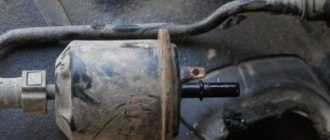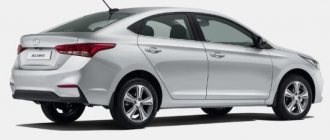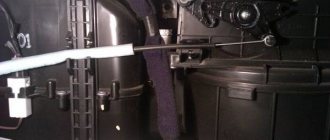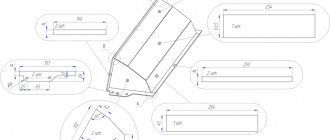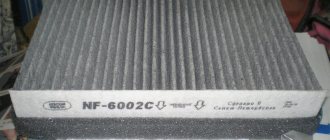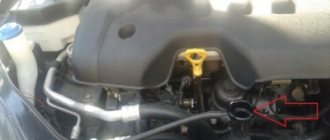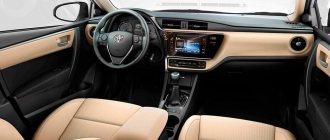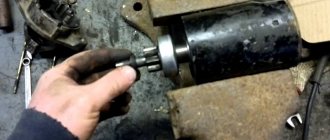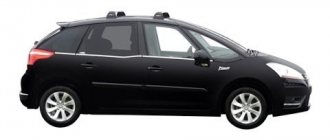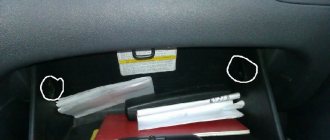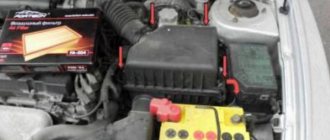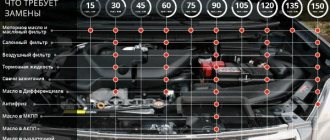A cabin filter is necessary for any car, even if it does not have air conditioning, and in the summer the owner drives with the windows open - it will still help out in a traffic jam, it will keep in the foxes that inevitably get into the ventilation and love to fly out dry at maximum fan speed anywhere from deflectors. So even in the poorest trim levels of the Accent, where the filter was optional, it had already been installed by the owners a long time ago - especially since it is not at all difficult to find where the filter is located on this car.
If you replace the cabin filter on a Hyundai Accent yourself, you are unlikely to spend a lot of time, and it’s certainly not worth contacting a service center for this.
Article number and cost of the original cabin filter and its analogues
The Hyundai Accent uses several types of cabin filters, depending on the year of manufacture of the car and its configuration. On early versions of the car, a consumable was used, the article number of which is 971331E000. According to reviews from car owners, it is produced at the TagAZ plant. The price of a filter ranges from 800 to 1500 rubles.
On later versions of the Hyundai Accent, a cabin filter with catalog number 971332H001 is used. It is not interchangeable with the old consumables. The cost of the filter element ranges from 1000 to 1800 rubles.
A completely different cabin filter is installed on vehicles equipped with air conditioning. This air purifier has article numbers 971331E100 and 976171C000. The filter goes on retail sale at prices ranging from 880 to 2100 rubles.
Third-party manufacturers produce cabin filters for Hyundai Accent of all years and in various trim levels. The tables below contain selections of the best analogues that perform excellently on the Hyundai Accent.
Table - Analogs of the original old-style cabin filter
| Firm | Article number | Approximate cost, ruble |
| Profit | 15212157 | 210-270 |
| Shafer | SA447 | 200-270 |
| Japan Cars | B40511PR | 190-250 |
| CRB | 971331E000 | 240-300 |
| Parts-Mall | PMAP20 | 280-370 |
Table - List of analogues of the new branded cabin filter
| Manufacturer | Catalog number | Price, ruble |
| Knecht-Mahle | LA447 | 680-780 |
| Parts-Mall | PMA024 | 190-230 |
| Kolbenschmidt | 50014772 | 320-400 |
| Wunder | QC0835WU | 260-310 |
| Profit | 15212162 | 200-250 |
Table - The best analogs of the original filter for Hyundai Accent with air conditioning
| Brand | Article number | Estimated cost, ruble |
| Bosch | 1987432204 | 540-690 |
| Kamoka | F415501 | 340-440 |
| Denckermann | M110538 | 220-270 |
| Mfilter | K9064 | 290-350 |
| Parts-Mall | PMA020 | 185-330 |
When to change, what interior to install
To perform scheduled maintenance operations, there are regulations, as well as manufacturer recommendations. According to them, replacing the cabin filter of the Hyundai Accent II LC heating and air conditioning system should be done every 15,000 kilometers or once a year.
Considering that the operating conditions of the car in most cases will be far from ideal, experts advise performing this operation approximately twice as often, in spring and autumn.
Characteristic symptoms:
- Windows often fog up;
- the appearance of unpleasant odors in the cabin when the airflow is turned on;
- deterioration of the stove and air conditioner;
They may make you doubt that the filter element is coping with its tasks and an unscheduled replacement will be required. In principle, these symptoms should be relied upon when choosing the correct replacement interval.
Suitable sizes
When choosing a filter element, owners do not always use products recommended by the car manufacturer. Everyone has their own reasons for this, some say that the original is unreasonably expensive. Some people in the region sell only analogues, so there is a need to know the sizes by which you can subsequently make a selection.
2 elements with dimensions:
- Height: 12 mm
- Width: 100 mm
- Length: 248 mm
As a rule, sometimes analogues for the Hyundai Accent II LC may be a few millimeters larger or smaller than the original, there is nothing wrong with that. And if the difference is measured in centimeters, then of course it’s worth looking for another option.
Selecting an original cabin filter
The manufacturer recommends using exclusively original consumables, which, in general, is not surprising. They themselves are of good quality and are widely available in car dealerships, but their price may seem overpriced to many car owners.
Regardless of the configuration, on all second-generation Hyundai Accents (including the restyled version), the manufacturer recommends installing a cabin air filter with article number 97617-1C000 (976171C000). But you can also install the original analogue with number 97617-1C001, the dimensions are the same, the width and height are the same.
The salon in this model is composite and consists of 2 parts. They are completely identical in size, the only difference being the so-called tongue-and-groove system on the side plastic edges.
It is worth noting that sometimes consumables and other spare parts may be supplied to dealerships under different part numbers. Which can sometimes confuse those who want to purchase an original product.
When choosing between a dust and carbon product, car owners are advised to use a carbon filter element. This filter is more expensive, but it cleans the air much better.
It is easy to distinguish - the paper filter accordion is impregnated with a carbon composition, and therefore has a dark gray color. The filter cleans the air flow from dust, fine dirt, germs, bacteria and enhances the protection of your lungs.
Which analogues to choose
In addition to simple cabin filters, there are also carbon filters that filter the air more effectively, but they are more expensive. The advantage of coal SF is that it does not allow foreign odors coming from the road (street) to penetrate into the car interior.
But this filter element also has a drawback - air does not pass through it well. GodWill and Corteco carbon filters are of fairly high quality and are a good replacement for the original.
However, in some retail outlets the price of the original second-generation Hyundai Accent cabin filter may turn out to be greatly inflated. In this case, it makes sense to purchase a non-original consumable item. In particular, cabin filters are considered quite popular:
Conventional dust cabin filters
- Mann Filter CU 2506-2 – high-tech consumables from a well-known manufacturer
- BIG filter GB-9839 – popular brand, good fine cleaning
- Nevsky filter NF-6159-2 - Russian manufacturer with an affordable price
Carbon cabin filters
- Amd FC17C – high-quality and thick carbon coating
- BIG filter GB9839/C – activated carbon
- Nevsky filter NF6159C-2 – normal quality, affordable price
It makes sense to take a closer look at the products of other companies - they also specialize in the production of high-quality consumables for passenger cars:
- Corteco
- Filtron
- SCT
- Sakura
- GoodWill
- Fram
- JS Asakashi
- Champion
- Zekkert
- Masuma
- Nipparts
- Purflux
- Knecht Mahle
- RU54
It is quite possible that sellers may recommend replacing the Accent II LC cabin filter with non-original cheap substitutes with a much smaller thickness. They are not worth buying, since their filtering characteristics are unlikely to be at the proper level.
Replacement frequency
The frequency of replacing the cabin filter directly depends on the operating conditions of the vehicle. On average, installation of a new consumable is required every 10-15 thousand km. There are a number of factors that make it necessary to shorten the interval. These include:
- the route runs along dusty dirt roads;
- the machine is operated in places with abundant flowering plants;
- The path often runs near production with harmful emissions;
- the vehicle often gets stuck in traffic jams or moves in dense city traffic.
Comparison of old and new cabin filters
Choice of SF Hyundai Accent
The first generation Accent, produced during 1999-2005, was equipped with a filter with article number 97617-1C000, which consisted of two rectangular filter elements that were placed one above the other. Each of them was equipped with its own frame, which was complemented by a handle that made it easier to pull the product out of the compartment. Since 2005, the Accent has been equipped with a regular single cabin filter (article 97133-1E100), albeit without a frame. For this reason, replacing the Accent Tagaz cabin filter is much easier, although the niche for the filter and the total dimensions of the single and dual cleaning elements are the same.
The double filter is generally a unique design solution. Forced, since it is extremely difficult to install a whole product on first-generation cars, but separately they become quite simple. One way or another, original cabin filters are rarely purchased today, preferring cheaper options from well-known manufacturers of similar products. In particular, for Hyundai Accent produced before 2005, the following products can be considered a good alternative:
- Nevsky filter (article NF6159/2);
- TSN (article 9.7-13);
- Finnwhale (item AS738);
- Kolbeschmidt (item 50013894).
For cars that came off the assembly line after 2005 (Tagaz assembly), the following filters will be suitable:
- Nevsky filter (article NF6425);
- Champion (item CCF0186);
- TSN (article 9.7-547);
- Finnwhale (item AS742).
Unfortunately, domestic dealers specializing in sales of Hyundai Accent often practice pre-sale preparation without installing a cabin filter on the car. Apparently, believing that this part can hardly be called in demand among drivers. About ten years ago, it really was a novelty, and car owners did not see the benefits of owning it, considering the troubles of replacing it burdensome. Today the situation has changed diametrically - no one wants to breathe dirty air with unpleasant odors, so configurations with a missing filter are becoming unpopular.
The place behind the glove compartment, where the cabin air filter is located on the Hyundai Accent, is standard for many brands and models of cars, so there are usually no problems with dismantling the old and installing a new product. As for the filter itself, some car enthusiasts prefer not to buy a finished part, but to make it themselves. As a rule, the quality of such a product is not much inferior to the factory one, but in terms of cost, this option is clearly preferable, especially if the owner of the car loves and knows how to do repairs without resorting to the help of professionals.
Description of replacing the cabin filter on a Hyundai Accent
Instructions for replacing the cabin filter on a Hyundai Accent are presented below.
- Open the glove compartment.
- Press the latches.
Location of glove box latches
- Remove the glove box clips and fold it down.
Removed clips
- To make it easier to replace the filter, many car owners recommend completely removing the glove compartment. To do this, unscrew a couple of its fasteners.
Mounting location
- Use pliers to disconnect the cable.
Disconnecting the cable
- Remove the filter housing latch.
Latch
- Remove the cabin filter cover.
Cabin filter cover
- Clean the seat.
Seat
- Insert new filter element.
Installed new cabin filter
- Reassemble everything in reverse order.
Step-by-step replacement instructions
Activities to replace consumables do not require any tools - just take a thin screwdriver.
- To access the SF cover, open the storage compartment.
- Take out all the things from it, find two plastic seals.
- To remove them, you need to pry them off with a screwdriver.
- After all the seals are removed, the compartment will fall down.
- The cover is easy to find, but access to it is blocked by the air valve rope.
- If you remove it from the bulge on the cover, you can then remove the cover from the clamps, but a single consumable will not allow you to get free movement of the rope. Therefore, we remove its end from the valve and remove the rope down.
On machines with a double filter, both parts can be removed one at a time without unfastening the valve rope. In any situation, installing a new part is not difficult.
Making your own filter
The original cabin filter is expensive, and its analogues do not always provide sufficient air purification.
Therefore, in order to save money, some car owners make their own consumables. To do this, you must follow the instructions below.
- Take an old cabin filter from a Hyundai Accent.
- Using a utility knife, cut out the used work area.
Getting a frame
- Make a new work area from a kitchen hood filter element.
- Glue the frame and filter area together.
Self-made filter
Why is it so important to replace on time?
You should also talk about the timeliness of replacement. Timely replacement ensures proper operation of the air conditioning and heating of the Hyundai Accent interior. In addition, timely replacement makes it possible to most effectively capture microscopic particles of dust and various plants that penetrate into the interior and not only settle on its surfaces, but also cause allergic reactions in the respiratory system of people using the car.
You can also highlight a certain driving hazard created by a dirty cabin filter, since large accumulations of dirt and dust begin to prevent the penetration of air into the cabin, as a result of which the windows of the Hyundai Accent fog up, and the driver himself begins to get more tired and react worse to various driving situations. In winter, a contaminated part leads to a decrease in the performance of the heating system, as a result of which it becomes quite cold inside the car, and the windows begin to fog up more.
Cabin filter for Hyundai Accent
Some dealers involved in the supply and sale of Hyundai Accent cars, for some reason, believe that the interior fittings are an optional element and do not include it in the package. During pre-sale preparation, parts are installed on the Hyundai Accent quite rarely, as a result of which the cars end up with their owners without this inconspicuous, but quite important part.
The standard cabin filter for a Hyundai Accent consists of two halves installed behind the glove compartment in the ventilation system. If you need to replace the fitting, you can purchase a new product in the store, or you can make it yourself using available materials and tools. The quality will be slightly lower, but quite sufficient for a certain mileage of the car.
We recommend: Anti-corrosion treatment of car body
